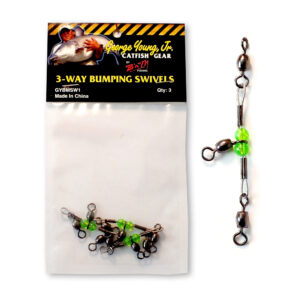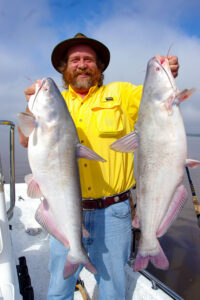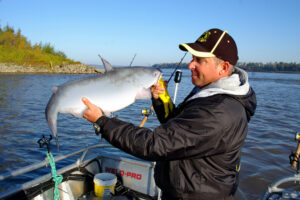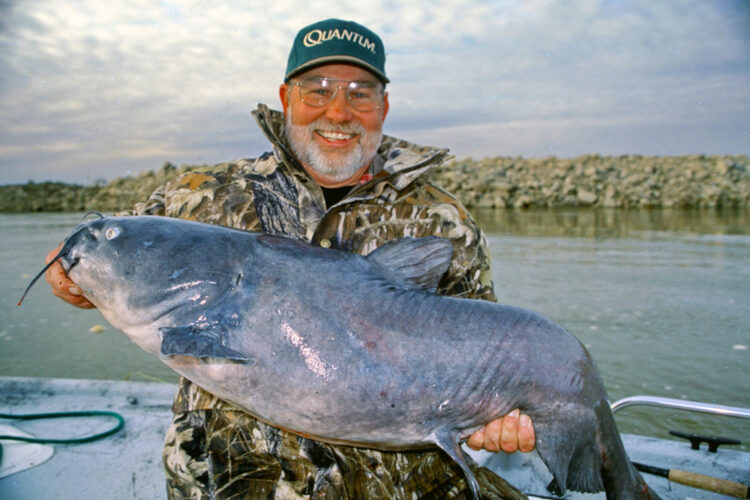Sitting on a deep wintering hole often produces monster Mississippi River blue cats like this hawg caught by guide James Patterson of Bartlett, Tennessee. (Keith Sutton Photo)
Three Tactics for Mississippi River Blues
by Keith “Catfish” Sutton
To catch more blue cats in North America’s second longest river, try these tried and proven methods.
In Mark Twain’s “The Adventures of Huckleberry Finn,” Huck caught “a catfish that was as big as a man, being six foot two inches long, and weighed over 200 pounds … It was as big a fish as was ever catched in the Mississippi, I reckon.”
There’s little doubt that fish was a blue cat, and while it was just an imaginary fish in Samuel Clemens’ fictional classic, the Father of Waters really does produce monster blues over 100 pounds. There are plenty of eating-size blues, too—so many, in fact, it’s not uncommon to catch 200-300 pounds of them during a good fishing day.
I’m still learning good tactics from fellow anglers who seem to be growing in number every year. But often as not, when it’s Mississippi River blues I’m after, I rely on the following three methods learned during 50 years fishing the river where it flows through Arkansas and Memphis. They’ll work for you, too.
Sitting on Wintering Holes
When November arrives, Mississippi River blue cats start congregating in deep wintering holes. All through the cold months, they hold in water over 50 feet deep because these spots offer shelter from the cold, swift currents and harbor large schools of baitfish such as shad and small carp. Resting areas and plentiful forage attract sometimes enormous schools of cats that range from 5 to 50 pounds or more.

Each fishing day this time of year starts with bait gathering and preparation. I try to find shad schools using a fish-finder. Most are at depths of 20 feet or more, and I catch them by throwing a wide-meshed cast net. Unfortunately, Asian carp have become so abundant, this doesn’t always prove productive, so instead I’ll use cut-bait prepared from skipjacks caught on a sabiki rig or live carp bought from commercial fishermen. When available, my favorite baits for trophy blues are 8- to 10-inch live carp.
A three-way rig anchored with a 6- to 10-ounce weight is my usual way to fish. I prefer 30- to 50-pound-test braided line on an Abu-Garcia C3 baitcasting reel with a 7-1/2-foot Berkeley E-Cat rod, and use a 7/0 Daiichi Circle Wide hook in Bleeding Bait Red run completely through the cut bait or behind the top fin on live baits.
Once I’m rigged and ready, it becomes a game of patience. I anchor above the hole I intend to fish—often a plunge hole at the end of a wing dike. Then I cast to the spot and let the reel free-spool until the weight hits bottom. Sometimes I’ll have out 200 feet of line. Blues usually hit hard and quick, so rod holders are necessary if you fish more rods than you can hold. A big blue could hit almost immediately if you’re in the right place, but you could fish a good hole for several hours before you hook a trophy.
Bumping
Another tactic that should be on the must-learn list for Mississippi River blue cat anglers is bumping. Instead of sitting in one spot and waiting for a fish to follow the scent trail to your bait, bumping lets you take the bait to the fish. It’s a natural presentation that mimics food washing downstream to catfish waiting in ambush. The bumping name derives from the feel of the bait bumping across the Mississippi’s washboard-like bottom while you drift.

A modified three-way rig works well for this tactic, made with a George Young 3-Way Bumping Swivel from B’n’M Poles. The hook line is 50-pound braid so it can handle big cats without breaking. The sinker line is lighter mono so if the weight snags, it can easily be broken loose with only the loss of the lead. The weight should be ample to allow the rig to bump bottom while you feed your main line further and further behind the boat. Bait is a chunk of shad or skipjack.
To begin, point your boat’s bow upstream and use your trolling motor to reduce your drift speed by half or more. If the current is 3 mph, for example, you want to reduce your drift speed to 2 mph or even 1. Now your boat is going slower than the current, so your bait also travels slower downriver. Actively feeding catfish that lay facing upstream will grab passing baits.
Keep your fishing combo in your hands, placing the reel in free spool and releasing line to a point several hundred feet behind the boat. Slightly raise the rod tip, then let out enough line for the bait to contact the bottom again. Let sit for a second and repeat until your rig is 500 feet back.
Ideally, when the bait is properly positioned, it will skip along 6 inches at a time. You should feel every log, rock and contour. If the water gets shallower, reel in line to stay in touch. If your rig drops into a hole, let some line out. Be prepared for a strike whenever you feel a rock, log or other bottom feature.
Eaters on Riprap
If you just want some eating-size cats for your next fish fry, target small blues on the abundant riprap along the banks of the Mississippi. These large, loose rocks cover the shoreline to help control erosion, and the cats’ favorite foods—baitfish and crayfish—are abundant there.

Hang-ups are common, so keep riprap fishing rigs simple. When fishing shallow edges, I prefer nothing more than a 4/0 to 6/0 octopus or circle hook with a small cut-bait chunk. Cast near a tree, boulder or other spot that differs from most of the riprap covering, then allow the baited hook to flutter down enticingly.
When targeting deeper riprap edges, try a 1/4- to 1-ounce jighead baited with cut-bait, minnows or crayfish. Work this with a “drop, lift, drop, lift” action, which is ideal for targeting blue cats holding in crevices between rocks.
Here’s another fun riprap tactic: try artificial lures instead of natural baits. Many baitfish- and crayfish-imitating crankbaits will take blue cats when bounced through the rocks. Deep-diving models work better as the longer bill helps keep the line from snagging. Riprap catfish also will hit a variety of jigs and spinners. Good luck!



